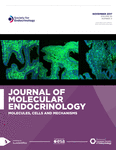New insights into the structure and mechanism of iodothyronine deiodinases
- Institut für Biochemie und Molekularbiologie, Rheinische Friedrich‐Wilhelms‐Universität Bonn, Nussallee 11, 53115 Bonn, Germany
1Lehrstuhl Biochemie, Universität Bayreuth, Universitätsstrasse 30, 95445 Bayreuth, Germany
- Correspondence should be addressed to U Schweizer; Email: ulrich.schweizer{at}uni-bonn.de
Abstract
Iodothyronine deiodinases are a family of enzymes that remove specific iodine atoms from one of the two aromatic rings in thyroid hormones (THs). They thereby fine-tune local TH concentrations and cellular TH signaling. Deiodinases catalyze a remarkable biochemical reaction, i.e., the reductive elimination of a halogenide from an aromatic ring. In metazoans, deiodinases depend on the rare amino acid selenocysteine. The recent solution of the first experimental structure of a deiodinase catalytic domain allowed for a reappraisal of the many mechanistic and mutagenesis data that had been accumulated over more than 30 years. Hence, the structure generates new impetus for research directed at understanding catalytic mechanism, substrate specificity, and regulation of deiodinases. This review will focus on structural and mechanistic aspects of iodothyronine deiodinases and briefly compare these enzymes with dehalogenases, which catalyze related reactions. A general mechanism for the selenium-dependent deiodinase reaction will be described, which integrates the mouse deiodinase 3 crystal structure and biochemical studies. We will summarize further, sometimes isoform-specific molecular features of deiodinase catalysis and regulation, and we will then discuss available compounds for modulating deiodinase activity for therapeutic purposes.
- Revision received 29 August 2015
- Accepted 16 September 2015
- Made available online as an Accepted Preprint 21 September 2015
- © 2015 Society for Endocrinology











